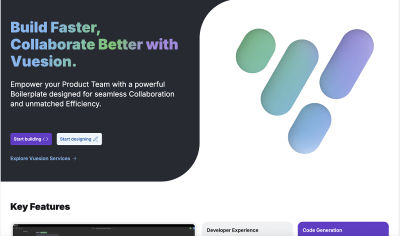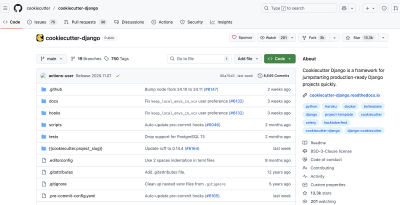Developer Tools
Starters, SDKs, infra helpers, and utilities for building apps faster.
Showing 2 of 2 apps

Vuesion
Vuesion is a full-stack Nuxt and Vue boilerplate with a built-in design system, authentication, PWA, i18n, and robust testing so product teams can ship modern web apps faster with best practices baked in.
by vuesion

Cookiecutter Django
Cookiecutter Django
by cookiecutter
Developer tools accelerate application development and deployment through pre-built components, services, and utilities. The best solutions combine powerful functionality with excellent developer experience to reduce time-to-market and improve code quality across the development lifecycle.
Popular subcategories
- Boilerplates & Starters — Pre-configured project templates with auth, database, UI, and DX setup.
- APIs & SDKs — Payment, authentication, storage, email, and search services with developer libraries.
- Headless Services — Backend-as-a-Service for CMS, commerce, and application infrastructure.
- Code Quality — Linting, formatting, static analysis, and code improvement tools.
- Testing — Unit, integration, E2E, and API testing frameworks and utilities.
Who builds developer tools?
- Infrastructure companies providing backend services and developer platforms
- Open source maintainers creating frameworks, libraries, and development utilities
- DevOps teams building internal tools and improving development workflows
- SaaS companies offering developer-focused APIs and integration services
- Individual developers solving common problems and sharing solutions with the community
Core developer tool mechanics
- Developer experience (DX): Intuitive APIs, comprehensive documentation, and smooth onboarding
- Integration simplicity: Easy setup, clear examples, and minimal configuration requirements
- Performance optimization: Fast response times, efficient resource usage, and scalable architecture
- Reliability and uptime: Stable services with proper error handling and fallback mechanisms
- Community support: Active forums, responsive support, and collaborative development
- Continuous improvement: Regular updates, feature additions, and bug fixes based on user feedback
Key features to evaluate
- Documentation quality: Comprehensive guides, API references, and practical examples
- Integration ease: Simple setup process, clear configuration, and minimal dependencies
- Performance metrics: Response times, throughput, and resource efficiency
- Scalability support: Ability to handle growth in usage and complexity
- Security standards: Authentication, authorization, and data protection measures
- Community ecosystem: Third-party integrations, plugins, and community contributions
- Pricing transparency: Clear cost structure, usage limits, and scaling options
Development workflow integration
Local development:
- Development servers: Hot reload, debugging tools, and local environment setup
- Package management: Dependency resolution, version control, and update mechanisms
- Code generation: Automated scaffolding, boilerplate creation, and template systems
- Environment configuration: Settings management, secrets handling, and multi-environment support
Build and deployment:
- Build optimization: Bundling, minification, and asset optimization
- CI/CD integration: Automated testing, deployment pipelines, and release management
- Container support: Docker integration, orchestration, and deployment automation
- Cloud deployment: Platform-as-a-Service integration and infrastructure automation
API design and developer experience
API design principles:
- RESTful architecture: Consistent endpoints, HTTP methods, and status codes
- GraphQL support: Flexible querying and efficient data fetching
- Webhook systems: Event-driven integrations and real-time notifications
- Rate limiting: Fair usage policies and performance protection
Developer experience optimization:
- Interactive documentation: API explorers, code examples, and testing interfaces
- SDK availability: Libraries for popular programming languages and frameworks
- Error handling: Clear error messages, debugging information, and resolution guidance
- Versioning strategy: Backward compatibility and smooth migration paths
Modern development stack considerations
Frontend frameworks:
- React ecosystem: Next.js, Gatsby, and React-specific tooling
- Vue.js tools: Nuxt.js, Vite, and Vue development utilities
- Angular support: CLI tools, libraries, and enterprise features
- Framework-agnostic: Universal tools that work across different frontend technologies
Backend technologies:
- Node.js ecosystem: Express, Fastify, and serverless framework support
- Python tools: Django, Flask, and FastAPI integration
- Go utilities: High-performance tools and microservice support
- Multi-language support: Polyglot development and cross-platform compatibility
Security and compliance
Authentication and authorization:
- OAuth integration: Social login, enterprise SSO, and identity management
- JWT handling: Token generation, validation, and refresh mechanisms
- Role-based access: Permission systems and user management
- Multi-factor authentication: Enhanced security and compliance requirements
Data protection:
- Encryption standards: Data at rest and in transit protection
- Privacy compliance: GDPR, CCPA, and regional privacy regulations
- Audit logging: Activity tracking and compliance reporting
- Vulnerability management: Security scanning and patch management
Performance and scalability
Optimization strategies:
- Caching systems: Redis, CDN integration, and application-level caching
- Database optimization: Query optimization, indexing, and connection pooling
- Load balancing: Traffic distribution and high availability
- Monitoring tools: Performance tracking, alerting, and observability
Scalability planning:
- Horizontal scaling: Multi-instance deployment and load distribution
- Microservices architecture: Service decomposition and inter-service communication
- Serverless integration: Function-as-a-Service and event-driven architecture
- Global distribution: Multi-region deployment and edge computing
Open source vs commercial tools
Open source advantages:
- Community development: Collaborative improvement and peer review
- Transparency: Source code visibility and security auditing
- Customization: Ability to modify and extend functionality
- Cost efficiency: No licensing fees for core functionality
Commercial tool benefits:
- Professional support: Dedicated customer service and SLA guarantees
- Enterprise features: Advanced security, compliance, and management tools
- Stability assurance: Vendor commitment to maintenance and updates
- Integration services: Professional implementation and consulting
Emerging trends and technologies
AI and machine learning integration:
- Code generation: AI-powered code completion and generation tools
- Intelligent testing: Automated test case generation and optimization
- Performance optimization: ML-driven performance tuning and recommendations
- Security analysis: AI-powered vulnerability detection and remediation
Cloud-native development:
- Kubernetes tools: Container orchestration and management utilities
- Serverless frameworks: Function deployment and management platforms
- Edge computing: Distributed computing and edge deployment tools
- Multi-cloud support: Vendor-agnostic deployment and management
Developer community and ecosystem
Community building:
- Open source contributions: Collaborative development and code sharing
- Developer forums: Technical discussions and problem-solving communities
- Documentation wikis: Community-maintained guides and best practices
- Conference participation: Knowledge sharing and networking opportunities
Ecosystem development:
- Plugin architectures: Extensible platforms and third-party integrations
- Marketplace platforms: Tool discovery and distribution channels
- Integration partnerships: Collaborative tool development and cross-platform support
- Developer advocacy: Community engagement and feedback collection
Monetization strategies for developer tools
Business models:
- Freemium tiers: Basic functionality free with premium features
- Usage-based pricing: Pay-per-API-call or resource consumption
- Subscription plans: Monthly/annual access with feature tiers
- Enterprise licensing: Custom pricing for large organizations
Value proposition development:
- Time savings: Quantify development speed improvements
- Cost reduction: Compare tool costs to in-house development
- Quality improvement: Demonstrate reliability and security benefits
- Scalability enablement: Show how tools support business growth
Related categories
- AI & Automation — AI-powered development tools and automated workflows
- SaaS Tools — Business applications with developer-friendly APIs
- Design & Creative Tools — Design tools with developer integration capabilities
- DevOps & Cloud — Infrastructure and deployment automation tools
Tip: Successful developer tools prioritize developer experience over feature complexity. Focus on solving specific problems well, provide excellent documentation, and build strong community relationships for sustainable growth.
Key Features
- Boilerplates & starters (auth, DB, UI, DX presets)
- APIs & SDKs (payments, auth, storage, email, search)
- Headless services (CMS, commerce, cart backends)
- Code quality tools (linting, formatting, analysis)
- Testing frameworks (unit, E2E, API harnesses)
- Developer experience optimization
- CI/CD integration and automation
- Documentation and API references
Frequently Asked Questions
What makes a good developer tool in 2024?
Excellent documentation, intuitive APIs, fast performance, seamless integration, active community support, and focus on developer experience (DX). Modern tools prioritize simplicity and productivity.
Should I build custom tools or use existing developer platforms?
Use existing platforms for common needs (auth, payments, storage) and build custom tools for unique requirements. Focus development time on your core product differentiators.
How do I evaluate developer tools for my tech stack?
Consider integration ease, documentation quality, community size, performance impact, pricing model, and long-term vendor stability. Test with small implementations first.
What's the difference between SDKs, APIs, and boilerplates?
APIs provide endpoints for functionality, SDKs are libraries that wrap APIs for specific languages, and boilerplates are pre-configured project templates with common features implemented.
How important is developer experience (DX) for tool adoption?
Critical. Poor DX leads to low adoption regardless of functionality. Great DX includes clear docs, intuitive APIs, helpful error messages, and smooth onboarding experiences.
Browse by Subcategory
Boilerplates & Starters
Auth, DB, UI presets.
APIs & SDKs
Payments, auth, email SDKs.
Code Quality
Lint rules, static analysis.
Headless Services
API-first CMS, cart, search.
Testing Tools
Unit, E2E, API test kits.